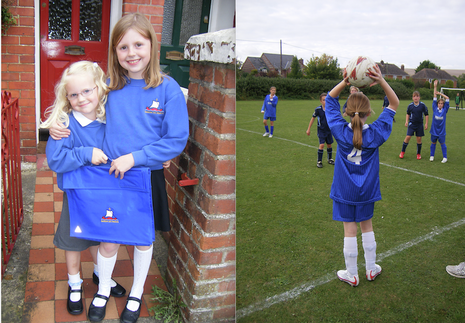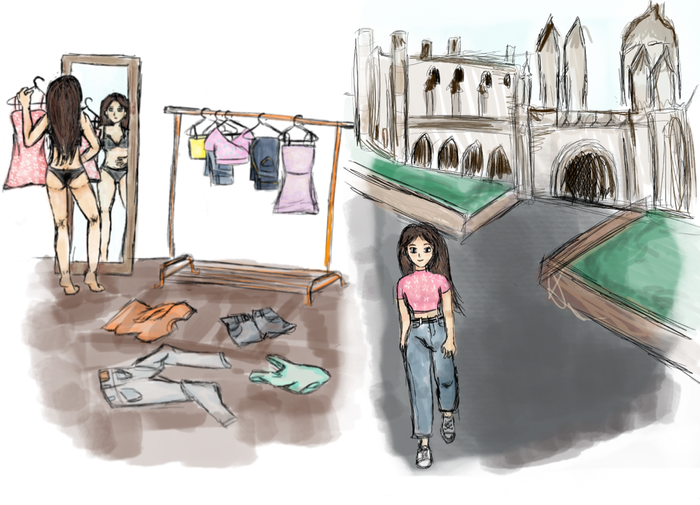The gendering of school uniforms: appropriate, practical, or outdated?
Reflecting on her school experiences, Becca Langford considers the complex ideologies behind school uniform and how it relates to contemporary issues of gender, fashion and identity

For the most part, I enjoyed an ungendered primary school experience. When I was in junior school you might have seen me wearing shorts in the summer, sporting football gear on a Thursday afternoon, or just jeans and a t-shirt on a non-school uniform day. This attire was pretty standard in my small, co-ed, state school. Mandatory dress codes; skirts, tights, dresses, for girls, trousers and shorts for boys, and regulations on which sports girls and boys were allowed to play was never a ‘thing’ at my school. It’s only recently, in light of contemporary debates on fashion and gender, that I have reflected and fully appreciated the significance of my experiences.
In true Cambridge fashion, let’s hold back from diving straight into the argument and explore some key terms. Clothes hold power; they also hold no power. Their significance depends on the power an individual or community deems them to have. Thus, imagine a universe in which humans don’t exist, and you could say that, in those circumstances clothes have no power at all. At the most basic, untouched level, clothes are simply mere pieces of fabric sewn together into different shapes and sizes. School uniforms, however, could be described as a set of standardised clothes used within educational institutions to (unsurprisingly) bring about uniformity. Clearly, uniforms have a lot of meaning, purpose and power.
“School uniforms can reduce elements of comparison within schools; there’s plenty of that already”
I don’t actually disagree with the notion of school uniforms at all, despite also advocating the importance of self-expression through clothes and fashion, regardless of age. Still, in my mind the purpose of a school uniform is to create balance. It prevents that rich kid who lives down ‘posh lane’ from walking in on the first day of Year 3 wearing their new set of top-notch Nike trainers their Dad bought for Christmas. By the same token, uniform mitigates the risk of the boy whose single mother lost her job last year and can’t afford to buy new clothes, sitting next to ‘rich kid’ feeling inadequate — aesthetically at least. In other words, school uniforms can reduce elements of comparison within schools; there’s plenty of that already. Giving students — particularly older ones — the reassuring space in which they don’t have to meticulously plan out their outfit each day, in my view, isn’t a prerequisite to limiting self-expression or freedom, it’s one less pressure for young people to deal with.
If at this point you’re thinking ‘don’t be ridiculous, children don’t care what they look like, they wouldn’t feel any pressure!’ consider this: I think as people, we long to belong. Many have argued that this desire is an ingrained human trait which develops as we do. From a social perspective, it could be said that clothes afford us the opportunity to belong. I’m sure we have all, at some point, gone to a party, event, non-uniform day and outfit planned with our friends, ensuring we planned on wearing the ‘right’ outfit, similar to others’, generally trendy but without being too similar. The thought of turning up to a party or interview and misunderstanding the dress code is enough to make even the most confident of us quake!
So now let’s imagine a uniform-free primary school. The ‘popular’ group of children all wear a specific brand of designer hoody. Other children in the class, with less social or economic status, may also be inclined to wear similar designer hoodies with the hopes of ‘fitting in’, assimilating into the dominant fashion culture. Uniforms could be said to take away this social pressure. I would go as far as suggesting school uniforms can provide a sense of equality; though mildly ironic given how very unequal and unmeritocratic the British education system currently is, uniforms ensure a component of student parity is maintained, in an otherwise hierarchical and stratified environment.
“Freedom of choice diminishes the gendered idea that clothes are binary”
However, with most schools (especially those in the private sector) continuing to uphold gender dress codes in an old-fashioned way (boys wear trousers and a jumper, girls wear skirts and a cardigan) could the argument be made that uniforms promote pre-existing inequality? I would argue no, but with many caveats. What would increase parity is choice! A girl should be able to wake up and decide she wants to wear trousers to school because they’re more practical for the day’s activities or more comfortable than tights, which have to be tugged up multiple times a day. A boy should be able to wake up and choose to wear a skirt for the day, because of its fun movement, flaring outwards when he spins, or because his best friend (let’s call her Chloe) likes wearing them too and they want to match. Enabling this freedom of choice diminishes the gendered idea that clothes are binary, and must always be split into two categories: male and female. Choice within a range of uniforms, and the the ability to interchangeably wear these items, would equalise the various dress codes and further progress to erase harmful, heteronormative gendered boundaries.
We could even go as far as arguing that choice within the boundaries of a gendered school uniform could afford children with opportunities for more productive and efficient classroom engagement. If the purpose of school is said to be truly centred around the principles of learning, then it only seems appropriate that children feel the most physically comfortable and the least self-conscious when doing so.
So, what does this mean for education? Let’s take some inspiration from Harry Styles’ 2020 Vogue cover, the women wearing business suits on national television, the boys who turned up to school wearing skirts on a hot summer’s day in protest against wearing trousers. Let’s stop making girls wear trousers as a punishment for rolling their skirts too high, let’s stop splitting uniform shops into two separate sections, let’s stop pretending that these ‘pieces of fabric sewn into different shapes’ really impact learning, and when we say that school uniforms promote equality, lets actually try and mean it, instead of splitting definitions of equality into two.
 News / CUP announces funding scheme for under-represented academics19 December 2025
News / CUP announces funding scheme for under-represented academics19 December 2025 News / Cambridge welcomes UK rejoining the Erasmus scheme20 December 2025
News / Cambridge welcomes UK rejoining the Erasmus scheme20 December 2025 Comment / Yes, I’m brown – but I have more important things to say22 December 2025
Comment / Yes, I’m brown – but I have more important things to say22 December 2025 News / SU reluctantly registers controversial women’s soc18 December 2025
News / SU reluctantly registers controversial women’s soc18 December 2025 Film & TV / Timothée Chalamet and the era-fication of film marketing21 December 2025
Film & TV / Timothée Chalamet and the era-fication of film marketing21 December 2025









